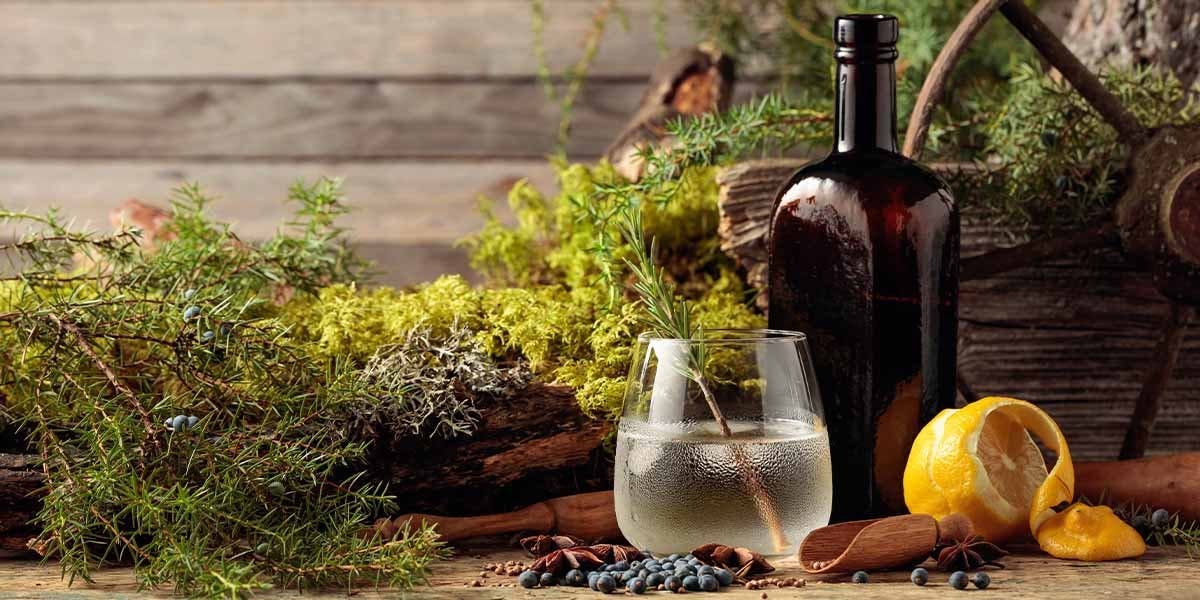
How to make gin at home in 10 easy steps
We work with some of the finest craft gin distillers here at Craft Gin Club, passionate people with years of experience, training and dedication behind them. (It’s why the gin tastes so amazing!)
However, gin in its most basic form is actually pretty straightforward: it’s simply a neutral spirit flavoured with botanicals (that’s any plant material used as a way to add flavour).
The only real stipulation for it to be called ‘gin’ is that juniper is the dominant botanical and it is at least 37.5% ABV.
While most ‘proper’, commercial gin makers extract the flavours from botanicals through distillation, it is possible to make gin at home by simply ‘steeping’ the plants, herbs or spices you want to use in the base spirit.
This means it is very possible to make your own gin at home using vodka!
The technical name for this is ‘compound gin’. It’s also sometimes called ‘bathtub gin’, which comes from the illegal batches of homemade gin that were often made in bathtubs during American Prohibition in the 1920s.
While we can’t guarantee it will taste as good as the lovely craft gin we send you every month, there’s nothing illegal about whipping up a bit of your own homemade gin – and it can be great fun too!
Here’s a basic recipe for how to make gin to get you started…
Beyond the vodka and the juniper berries, you can feel free to experiment with whatever botanicals you like. Some of the most commonly used gin botanicals (after juniper) are coriander seed, angelica root, citrus peel and cinnamon – but feel free to raid the spice cabinet and herb garden.
You could try bay leaves, rosemary, liquorice powder, lavender, cardamom, cumin, fennel seeds, lemongrass…pretty much anything you fancy.
If you’re not sure where to start, check out the botanicals that are included in your favourite commercial gins and use those for inspiration.
Happy gin making, gin lovers!
How to make gin at home:
Homemade Gin Ingredients:
- 750ml good quality vodka
- 2 tbsp juniper berries (more if you like juniper-forward gin)
- 1 tsp coriander seeds
- 2 cardamom pods
- 2 peppercorns
- Half a cinnamon stick
- A small piece of dried orange peel (remove the white pith as it’s very bitter)
- A small piece of dried lemon peel (again, no pith)
750ml good quality vodka
2 tbsp juniper berries (more if you like juniper-forward gin)
1 tsp coriander seeds
2 cardamom pods
2 peppercorns
Half a cinnamon stick
A small piece of dried orange peel (remove the white pith as it’s very bitter)
A small piece of dried lemon peel (again, no pith)
Method for how to make gin at home:
- Sterilise a clean mason jar or glass bottle with boiling water.
- Add your botanicals to the jar, minus any fresh peel.
- Top up with vodka.
- Leave to infuse in a cool dark place for 24 hours.
- Taste the infusion – it should have taken on some lovely juniper ginnyness already. Add your fresh peel, along with any extra botanicals whose flavour you want to boost.
- Leave for up to another 24 hours, giving the bottle a gentle shake at least once.
- Beware of leaving it too long and over-infusing the mixture – think of it a bit like brewing tea!
- Taste the gin again and if you’re happy, filter out all the botanicals using a sieve. If there’s still some sediment left, use some muslin or a coffee filter to strain again.
- Leave the liquid to sit for a couple of days and then filter out any remaining sediment – and put it through a water filter jug if you want to make it even clearer.
- Bottle your gin – feel free to create a label too – and you’re ready to try your creation out on your nearest and dearest!
Sterilise a clean mason jar or glass bottle with boiling water.
Add your botanicals to the jar, minus any fresh peel.
Top up with vodka.
Leave to infuse in a cool dark place for 24 hours.
Taste the infusion – it should have taken on some lovely juniper ginnyness already. Add your fresh peel, along with any extra botanicals whose flavour you want to boost.
Leave for up to another 24 hours, giving the bottle a gentle shake at least once.
Beware of leaving it too long and over-infusing the mixture – think of it a bit like brewing tea!
Taste the gin again and if you’re happy, filter out all the botanicals using a sieve. If there’s still some sediment left, use some muslin or a coffee filter to strain again.
Leave the liquid to sit for a couple of days and then filter out any remaining sediment – and put it through a water filter jug if you want to make it even clearer.
Bottle your gin – feel free to create a label too – and you’re ready to try your creation out on your nearest and dearest!
Note from the pros:
Without the final distillation process used by the pros, your batch of homemade gin will come out looking a bit yellowy or orange, depending on which botanicals you use.
This won’t do you any harm, but if you’d rather have a clearer-looking spirit, you can simply pass it through a water filter jug a few times (we don’t normally bother though as it doesn’t affect the taste!).
Don’t forget to share your results with us and your fellow gin fans on Facebook and Instagram!
And, now you’ve made your own gin, it’s time to whip up a few cocktails. Check out our Cocktail Hub here! There, you can find recipes for the perfect Martini, Negroni, and hundreds of other gin cocktails.













